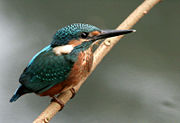Common Kingfisher
2008/9 Schools Wikipedia Selection. Related subjects: Birds
| Common Kingfisher | ||||||||||||||
|---|---|---|---|---|---|---|---|---|---|---|---|---|---|---|
 |
||||||||||||||
| Conservation status | ||||||||||||||
|
Least Concern
|
||||||||||||||
| Scientific classification | ||||||||||||||
|
||||||||||||||
| Binomial name | ||||||||||||||
| Alcedo atthis (Linnaeus, 1758) |
The Common Kingfisher or the European Kingfisher (Alcedo atthis), has a very wide distribution over Eurasia and Africa. This striking blue bird lives primarily besides water bodies.
Distribution
This species is widely distributed over Europe, Asia, and Africa. It is largely a resident species, but may migrate short distances from northern areas where the water surfaces freeze.
Habitat: It is a bird of the waterside, since it feeds entirely upon aquatic animals. It is frequent beside lakes, ponds, canals or dykes and streams. In winter, especially when inland waters are icebound, it may move to tidal marshes and the shore, taking its stand on the mussel or limpet covered rocks and diving into the shallow pools.
In most of its European range it is the only kingfisher. It may often be confused with the Small Blue Kingfisher, with which it overlaps in the southern areas of most of its range.
Description
- Size: Slightly larger than a sparrow (ca. 18-19cm., with wings averaging 7.5 cm),
- Appearance: Adult is bright metallic blue in the upper parts, cobalt on the back, and showing greenish reflections on the head and wings. The ear coverts and under parts are warm chestnut, the chin and sides of neck white.
The bill of the female is blackish and reddish orange at the base; the bill of the male is all black; the legs are bright red with a dark blue stripe. In the young the bill is black.
- Flight: The flight of the Kingfisher is rapid, the short rounded wings whirring until they appear a mere blur. It usually flies near the water, but during courtship the male chases the female through and over the trees with loud shrill whistles.
The Kingfisher sometimes hovers over the water, with body held almost vertical, the tail and head bent slightly forward and the bill inclined downward.
- Courtship: From February onwards the male has a trilling song, a modulated repetition of many whistles. He also signals with a whistle to the female when he is feeding her, this being his share of the nesting duties. This whistle is produced even when his bill is loaded with food, yet is clear and distinct. The female will reply and emerge from the nesting hole, and may fly to meet him, take the fish from him in the air, and return to the nest.
Food
The bird has regular perches or stands from which it fishes. These may be a few inches or many feet above the water. It sits upright, its tail pointed downwards. It drops suddenly with a splash and usually returns at once with a struggling captive.
Large fish are beaten on a bough or rail; small fish and insects are promptly swallowed. A fish is usually lifted and carried by its middle, but its position is changed, sometimes by tossing it into the air, before it is swallowed head downwards.
Fish, aquatic insects and crustaceans are eaten. It eats numerous freshwater shrimps Gammarus.



